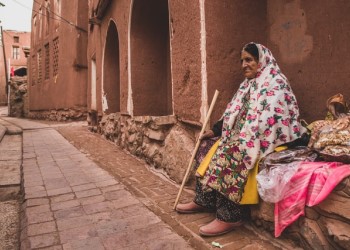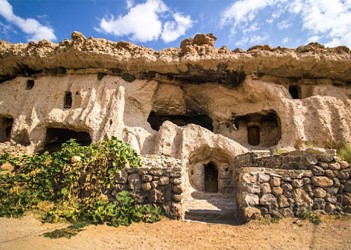Traveling to Iran, you can have a breathtaking experience by visiting traditional villages. There are some traditional villages in Iran where you can find an authentic view of Persian culture and civilization.
You can find traces of traditional architecture, culture, language, cuisine, and rituals in different villages of Iran. Besides, these villages have still dwellers, and you can enjoy socializing with local people in these villages.
Here we provide you some information about five traditional villages of Iran that you better put on your bucket list before traveling to Iran.
Best Villages in Iran to Visit
Abyaneh, Iran’s Traditional Village in Red

Abyaneh, known as the red village, is one of the highest settlements in Iran with an elevation of 2222 meters above sea level.
In fact, the village is located on the slope of Karkas Mountain near Natanz city and Kashan, Isfahan Province. Abyaneh is on Iran’s national heritage list.
The village was formed about 1500 years ago. Since according to archeologists, there are buildings of the Sassanid, Safavid, and Qajar eras. There are 500 houses, all are in the northern part of Borzroud River.
The village was originally named Viona, which means willow field in the local language since it has willow trees in ancient times. The red houses and traditional costumes of locals make it one of the attractions of Iran.
The authenticity of locals in their dialects, costumes, and rituals is a great aspect of this village. The women in Abyaneh wear two-tiered ruffle skirt. The colorful skirt is covered with a big floral charqad (big scarf). The men wear long shirts with loose pants.
Walking in the village, you can find handicrafts, whey, and fruit roll made by locals. Giveh, traditional shoes, and kilim are the main souvenirs of the village. You can find small shops in a traditional style. So it is a great way to take refuge from modern life. You can walk in the alleys surrounded by walls made with straw-clay plaster.
There is a fire temple, mill, caravanserais, and three castles from the past centuries in the village. Actually, the castles are refugees for people during attacks and natural disasters.
Read also: Things to Know about Persian Language before Traveling Iran
Kharanaq Village

Near Yazd city, there is a 4500-year-old Kharanaq village. The name of the village means ‘birthplace of the sun’ in the Yazdi language.
Kharanaq castle is one of the biggest residential castles of Yazd.
It dates back to the Sassanid era (about 1800 years ago).
It has 80 houses made of mud and brick. This is on Iran’s national heritage list. A 17th-century shaking minaret, caravanserai, hammam (bathhouse), mosque, mill, and ab anbar (water reservoir) are other landmarks of this village.
Today 145 families live in this village, who earn their living by farming and husbandry. There are also several mines near Kharanaq.
Read also: Best Things to Do and Experience in Iran
Meymand, a Village in the Heart of the Mountain

Meymand is another traditional village of Iran. It is 38 km from Shahr-e Babak city, Kerman Province. This man-made village is carved in the heart of the mountain. Actually, it is dated back to 2000 to 3000 years ago according to some clays found in Meymand.
There are some castles, temples, and towers in the village. Nobody knows which tribe firstly established this village. Kicheh is the hand-dug house. It has one entrance and the curtains divide spaces. The heating system is fire.
The Kichehs is 5 degrees warmer than the outside weather. There are 405 Kicheh in the village. The kicheh is a hand-dug structure and no brick or wood is used for its construction.
The people use some dialect of people in the village. There are still people living in Meymand. There is still an interaction between humans and nature. The dwellers earn life by farming and husbandry.
Kandovan, a Rocky Traditional Village in Iran
The conical architecture of Kandovan village is near Tabriz, Eastern Azerbaijan Province. This historical village is located on the foothill of the Sabalan Mountains.
According to some theories, it is on the Iran national heritage list. The establishment of the village is probably dated back to the Mongol invasion of Iran from 1219 to 1221.The building are mostly on two floors. There are some three and four-story buildings as well. There is a barn on the ground floor.
The first floor is for family inhibition. The other floors are the storehouse and for guests. Honey is the main product of Kandovan. Dairy, walnut, herbals, and almond are other products of the village.
There are still about 120 families living in Kandovan. There are also some new concrete buildings in Kandovan. If you pass the bridge over the Kandovan River and then climb to have a scenic view of Kandovan village.
Uramanat Village

This beautiful village is located in Kordestan Province, Iran. Uramanat village is on the UNESCO world heritage list for its unique rural texture, architecture, lifestyle, and agriculture.
The authentic language and their adaptation with nature by farming on the slope are amongst the attractions of the village.
The people talk in Urami language. They wear local costumes.
The Uramant village boasts special music and ritual. The most important of these rituals is Pir-e Shalyar. The event is held two times a year in mid-winter and mid-spring annually.
You can find several handicrafts like kilim, Giveh (traditional shoes), wooden dishes as well as nuts, dairy, and local bread.
Last But Not Least
Iran is a land of wonders and differences. You can find breathtaking beauties in different parts of Iran. There are many villages where you can find traces of history and authenticity. So traveling to Iran, do not miss this part of the country.



2 Comments
Beautiful villages, are they accessible via main roads?
Yes, these villages are located near the roads